► The most efficient electric cars on sale today
► Entrants from Tesla, Hyundai, Skoda and Fiat
► The best can manage more than 4.0 miles per kWh
The most efficient electric cars are can eke loads of miles from their batteries, and that means you have to charge them less – especially if you plan to use the car to regularly cover long distances. Efficiency isn’t as a popular metric as range, but it’s equally important if you plan to use your EV a lot – or if you appreciate the most advanced battery and motor technology.
For example, the top-spec BMW iX has an enormous 100kWh battery, but because it weighs 2.5 tonnes and has the same aerodynamic characteristics as a house brick, it can only deliver around 3 miles of range for each kWh of electricity in its battery.
The best efficient electric cars at a glance
Below, we’ve ranked the most efficient electric cars on sale today. To average out the weather variable, we calculated each car’s efficiency by dividing its official WLTP range figure by its battery capacity. We’ve also omitted the cars that are notoriously inefficient, such as the Toyota bZ4X and MINI Electric. In a similar tone, here’s the EVs with the longest range.
The most efficient electric cars of 2024
Vauxhall Corsa Electric – 5.0 miles per kWh
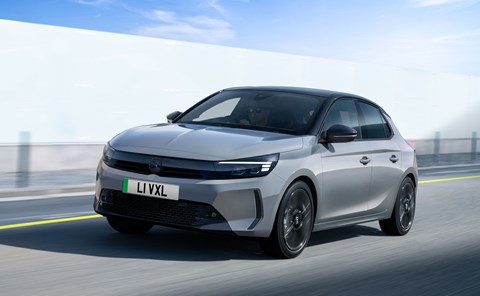
Britain’s best-selling car is also available as a rather frugal EV
Pros: Recent facelift brings sharper styling, more tech and extra range
Cons: Lacks sparkle
Vauxhall facelifted the Corsa Electric in May 2023 – and the brand took the opportunity to fit the supermini with a larger 54kWh battery pack and a more powerful electric motor. The changes have brought some impressive efficiency gains, at least on paper. Using our calculation, it’s capable of delivering up to 5.0 miles per kWh, making it one of the most efficient electric cars on sale.
Naturally, we’ll need to wait until we’ve driven the revised Corsa Electric before we can endorse it. That’s because Stellantis electric cars have a habit of under-delivering on their efficiency claims. The outgoing version of the Corsa, for example, claimed a maximum range of 209 miles but could only deliver 180-ish miles in the real world, giving it an efficiency figure of around 3.6 miles per kWh.
Read our full Vauxhall Corsa Electric review
Fiat 500 Electric 42kWh – 4.8 miles per kWh
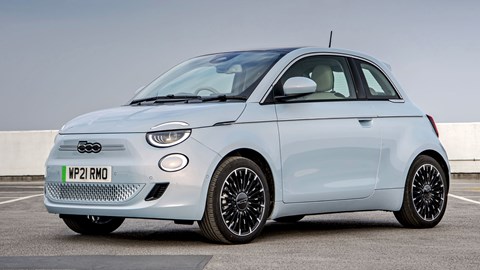
Fiat’s cutesy city car offers good efficiency (if you drive it carefully)
Pros: Willing electric motor, engaging driving experience, pleasant interior
Cons: Limited practicality, entry-level model trades range for cost
If you want a fun electric car, you can’t do much better than the Fiat 500 Electric. It’s small, it’s agile, it has an incredibly eager electric motor, and it retains all the cutesy retro charm that made its petrol-powered predecessor such a hit. It’s also rather efficient. Our best-case scenario calculation suggests the range-topping 42kWh model will return almost 5.0 miles per kWh in ideal conditions. Worst-case figures are less impressive, but it you should still see numbers in the mid-3.0 mile per kWh range.
The trouble with the Fiat is that you can only achieve those economy figures if you’re prepared to drive it gently – and it’s so much fun to tear around in that you’ll inevitably end up thrashing the tyres off it and chewing through your battery capacity.
Read our full Fiat 500 Electric review
Renault Megane E-Tech Electric – 4.6 miles per kWh
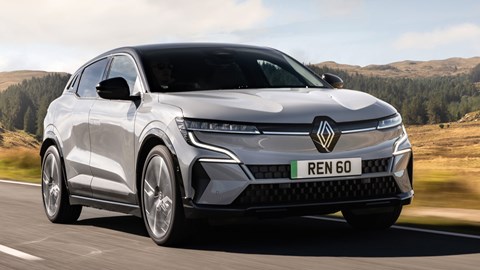
Technologically brilliant and great fun to drive
Pros: Intuitive infotainment system, sharp chassis, practical
Cons: Choppy ride on largest 20-inch alloys, only one battery option
We like the Renault Megane E-Tech. Not only is it practical, good fun to drive and loaded with clever technology, but it’s also quite efficient. Our calculation estimates it can achieve 4.6 miles per kWh of battery capacity at a maximum range of 280 miles. Granted, this is a best-case scenario figure – catch the Megane on a cold winter’s morning, and its efficiency figure will drop into the low 3.0-mile per kWh range.
However, we found the car’s range indicator to be frighteningly accurate, which allows you to plan your charging stops with greater accuracy and squash range anxiety. We took the Megane on a 70-mile route during its launch event, and according to the trip computer, the car used almost exactly 70 miles of electricity.
Read our full Renault Megane E-Tech Electric review
Volkswagen ID.3 77kWh – 4.5 miles per kWh
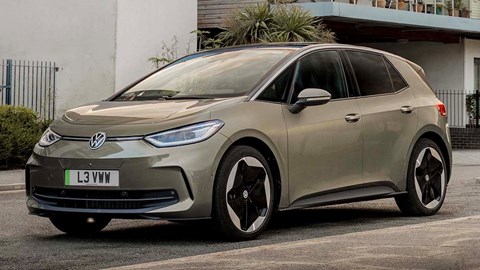
Approachable electric hatchback for long-distance drivers
Pros: Long electric range, sprightly performance, lots of equipment
Cons: Top-spec model is pricey, fiddly touch-sensitive controls survived the update
The ID.3 shares its platform with the Enyaq – and, because the Volkswagen is a smaller and lighter car, it improves on the Skoda’s efficiency. In ideal conditions, the ID.3 can cover up to 347 miles on a charge, with an average electricity consumption figure of 4.5 miles per kWh. Even if you’re not being particularly delicate with the accelerator, though, it should still manage upwards of 4.0 miles per kWh.
Volkswagen facelifted the ID.3 in early 2023. It was a mild update, with a few exterior styling and interior quality tweaks. We think the update has improved the ID.3 overall, but we’re disappointed that Volkswagen still hasn’t removed the car’s frustrating touch-sensitive climate controls and odd double-duty window switches.
Read our full Volkswagen ID.3 review
Tesla Model 3 – 4.3 miles per kWh
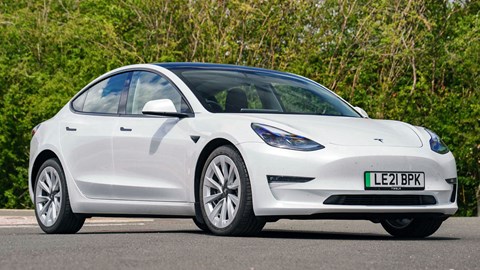
Class-leading technology and excellent value
Pros: Clever infotainment system, good range, strong performance
Cons: Numb steering, some build quality issues
The Model 3 has been a runaway success for Tesla. In 2021, the company sold 34,783 examples in the UK, making it Britain’s second best-selling car behind the Vauxhall Corsa. These booming sales figures are thanks in part to the Model 3’s impressive battery efficiency. Most electric cars can’t match their WLTP claimed figures – but the Tesla does what it says on the tin.
We were keen to scrutinise Tesla’s honesty, so we took a fully charged Model 3 Long Rang on a 200-mile road trip. At the end of our journey, the trip computer said the car still had 150 miles of battery capacity left. That means it nearly matched its official WLTP range of 360 miles, averaging around 4.0 miles per kWh. The most basic Model 3 is even more efficient. It has a smaller battery pack and is therefore lighter, meaning it can achieve 4.3 miles per kWh if driven gently.
Read our full Tesla Model 3 review
Kia Niro EV – 4.3 miles per kWh

Kia’s simple electric SUV is a great gateway to EV ownership
Pros: Good value for money, well-equipped, spacious
Cons: Choppy ride, poor Android Auto layout
The Kia Niro EV is a car you buy with your head rather than your heart. It makes a lot of practical sense because it’s easy to drive, it comes with plenty of technology, and it uses its battery efficiently enough to basically eliminate range anxiety. That is unless you plan to drive it to the top of Scotland.
We couldn’t find many faults with the car, which means you won’t have many headaches if you decide to opt for one as your first EV. The Niro’s biggest problem is its low-speed ride – the EV model has much firmer suspension than its hybrid sister cars, as it’s fighting with the added weight of the bigger battery pack. That means it bounces you around in your seat when you’re pottering around town. It smooths out well on the motorway, though. However, if you value comfort as much as you do efficiency, you’ll be better served by the Skoda Enyaq.
Read our full Kia Niro EV review
MG 4 EV Trophy Extended Range – 4.3 miles per kWh
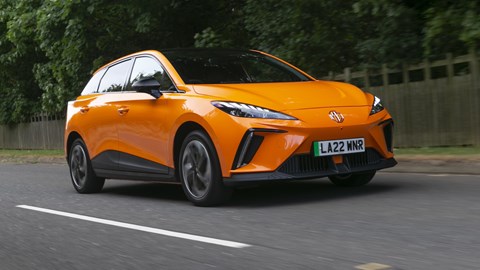
Bargain basement electric hatch makes stellar efficiency claims
Pros: Fantastically affordable, great fun to drive, accurate range indicator
Cons: Fiddly infotainment system, cheap cabin plastics
The MG 4 EV has been grabbing headlines since it was launched. When it was first unveiled, it traded on its attractively low price. Then we drove it and realised it’s a hoot on a windy B-road. Now, MG has surprised us again with a new 77kWh Extended Range variant that can compete with the best cars in its class on the efficiency front.
MG says the car can cover 323 miles in mixed driving conditions, which is enough to give the Volkswagen ID.3 a good run for its money and utterly embarrass the likes of the Renault Megane E-Tech and Vauxhall Astra Electric. We’re yet to drive the MG 4 EV Extended Range as it won’t arrive on UK shores until 2024, but we’ll update you once we’ve got behind the wheel.
Read our full MG 4 EV review
MG 4 EV Trophy Extended Range Lease Deals VIEW OFFER
Vauxhall Astra Electric – 4.2 miles per kWh

Vauxhall’s talented family hatch – now with electric power
Pros: Well-equipped, well-organised interior, honest EV range
Cons: Rather expensive for what it is, rivals have longer maximum ranges
The Astra Electric features the same 54kWh battery pack and 154bhp electric motor as the Corsa – and it shares its smaller sibling’s ruthless efficiency. It can manage more than 4.0 miles per kWh in the real world, which isn’t bad for a car of its size and weight. Just bear in mind that efficiency figure will tail off if you spend a lot of time on the motorway. The Astra is at its happiest on A- and B-roads.
The Astra’s biggest problem is how much it costs. Prices start from over £40,000, which looks like an awful lot of money alongside to the £36,500 you’ll spend on the MG above. We’re not convinced that it’s worth shelling out the extra cash for a slightly better interior and marginal gains in build quality.
Read our full Vauxhall Astra Electric review
Hyundai Ioniq 6 – 4.1 miles per kWh

Streamlined saloon offers sharp looks and a great range
Pros: Loaded with technology, good to drive, comfortable
Cons: Limited passenger space, only one battery option
The Hyundai Ioniq 6 was designed to knock the Tesla Model 3 off its perch. It offers a similar blend of swoopy styling and clever technology, although it can’t quite beat its main rival on the performance front (yet – a hot N model is on the way). However, it competes with Tesla rather well on the efficiency front. The rear-wheel-drive model can come awfully close to its maximum claimed range of 338 miles, delivering 4.0 miles per kWh if driven sensibly.
It’s also a very pleasant place to spend time, which is important given how long-legged it is. Its interior is comfortable and packed with technology, while its suspension is supple enough to round off most bumps on the motorway. It isn’t exactly slow either – the rear-wheel drive model has 225bhp and can sprint from 0–62mph in 7.4 seconds, while the four-wheel drive variant gets 321bhp and a 0–62mph time of 5.1 seconds.
Read our full Hyundai Ioniq 6 review
Skoda Enyaq iV 80 – 4.0 miles per kWh

Sensible electric car from a sensible car company
Pros: Comfortable, spacious, and efficient
Cons: It isn’t very exciting, nor is it particularly fast
Skoda’s electric SUV is predictably practical. It has a vast interior, loads of boot space, a comfort-biased suspension setup and the firm’s trademark suite of ‘Simply Clever’ features, which include umbrellas in the rear doors, luggage hooks in the boot and retractable sun blinds. It’s the ideal electric car for family life – a point that’s hammered home by its efficient electric powertrain.
Nobody wants to waste time waiting for their car to recharge on a family outing, but if you get the rear-wheel drive Enyaq iV 80, you’ll probably be able to get to your destination and back without recharging. We’ve managed to extract more than 260 miles from the car on a long motorway drive from CAR magazine HQ to the Lake District. It averaged just under 4.0 miles per kWh, and it still had a bit of range left in the battery when we arrived.
Read our full Skoda Enyaq iV review
How we test electric car efficiency
The efficiency of electric cars never used to be a concern, as the cost of charging them up was so much cheaper than fuelling a petrol or diesel car that even an inefficient EV would still reduce your vehicle running costs dramatically. That’s no longer the case in the days of 30p/kWh electricity and a general cost of living crisis, so EV efficiency is suddenly a big deal.
When we test EVs, we do our best to measure efficiency the same way we would on a petrol or diesel car – namely, charging the car up to full, taking it on a long drive over mixed roads, and then recharging it back to full and taking note of how many kWh were needed. It’s difficult to make this account for losses in the charging process, though, or different driving styles which affect EV range more than they would a petrol or diesel car, so for this list we’ve taken official figures from the WLTP testing procedure, which while they’re not always entirely accurate are at least consistent across all models.
Cold weather
Measuring the efficiency of an EV isn’t as simple as measuring the efficiency of a petrol or diesel car, as you can’t just measure the volume of fuel it consumes over a given distance. That’s because the amount of “fuel” an electric car can store changes according to the weather conditions.
In cold weather, the chemical reactions inside an electric car battery work more slowly, which effectively reduces the amount of electricity the cells can deliver. That, in turn, slashes an EV’s maximum range. Think of it like this – it’s as if the car’s fuel tank shrivels up in the cold, reducing the amount of fuel it can carry.
The Toyota bZ4X is a prime example of this foible. Toyota says that, under official WLTP testing, the car can cover up to 318 miles. But when we tested the EV during the winter, its range indicator suggested the furthest distance it could travel was 170 miles. That means it would only deliver a pitiful 2.7 miles per kWh rather than the 4.9 miles per kWh Toyota claims.
What to look for when buying an electric car
If you value efficiency above all else, start is by sizing up the specifications of the EVs on your shortlist. For the best results, find car with the most amount of battery capacity and the lightest possible kerbweight for the least amount of money.
Currently, the car that best sits in the middle of this Venn diagram is the MG 4 EV, but there are more affordable electric cars soon set to arrive on UK shores that’ll provide some stiff competition, such as the BYD Dolphin and the Ora Lightning Cat.
Another thing to bear in mind is charging speed. It’s all well and good owning an electric car with an enormous battery pack and a high maximum range – but its usefulness over extreme distances will be limited if you need to wait ages to charge it up. Hyundai and Kia are great at this.
The Ioniq 6 and EV6 both come with superfast 800V electrical systems as standard, which means they can charge from 10% to 80% capacity in just 18 minutes when plugged into a 350kW DC charger. That’s just long enough for a coffee.
Luke Wilkinson is a Senior Staff Writer for the Bauer Automotive Hub. He writes news, reviews, features and best of pages for both CAR magazine and our sister site, Parkers.